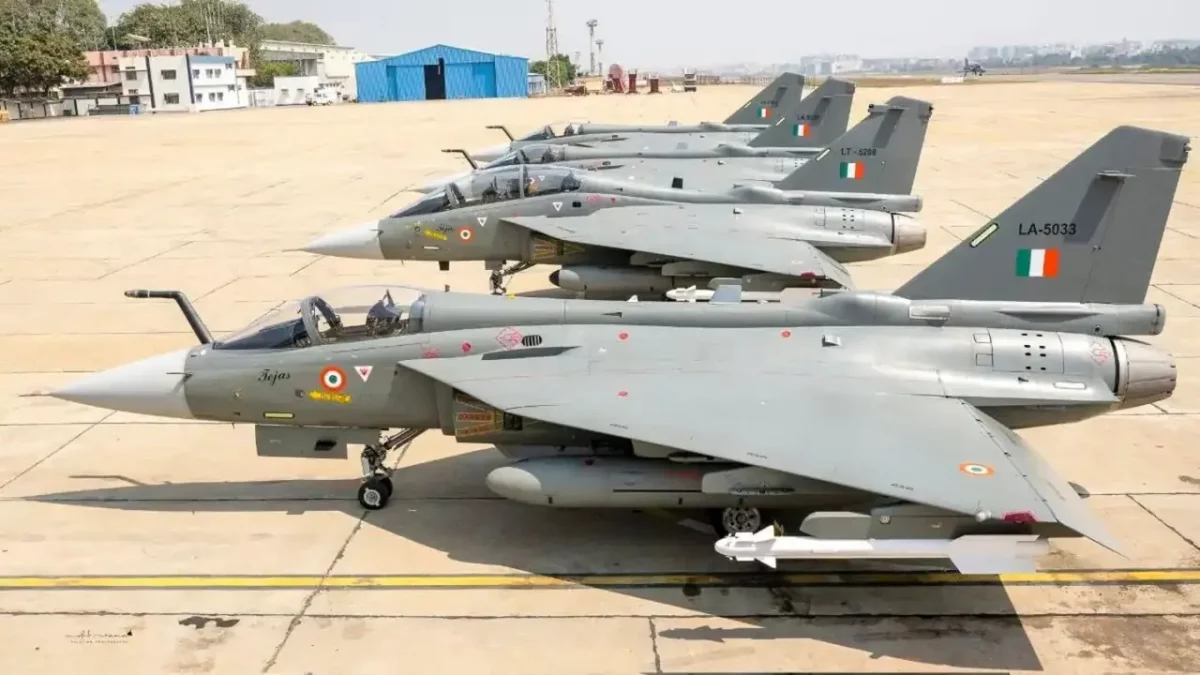In a major step towards India’s defence self-reliance, Defence Minister Rajnath Singh inaugurated the third production line for the Light Combat Aircraft (LCA) TEJAS Mk-1A at Hindustan Aeronautics Limited’s (HAL) Nashik facility, enhancing the country’s indigenous fighter jet manufacturing capability.
With the new line operational, HAL’s total TEJAS production capacity rises to 24 aircraft per year, with the Nashik unit alone capable of producing eight aircraft annually. This expansion comes at a crucial time as the Indian Air Force (IAF) faces a shrinking number of operational squadrons due to the gradual retirement of its ageing MiG series fighters.
A Boost for Indigenous Aircraft Production
During the ceremony, Rajnath Singh also inaugurated the second manufacturing line for the Hindustan Turbo Trainer-40 (HTT-40) and flagged off the first TEJAS Mk-1A built at the Nashik facility. Calling the successful test flight of the aircraft “a symbol of Atmanirbhar Bharat,” the Defence Minister said it demonstrates India’s rising capacity to produce world-class defence systems domestically.
The TEJAS Mk-1A is India’s most advanced variant of the indigenous LCA platform. It features Uttam Active Electronically Scanned Array (AESA) radar, the Swayam Raksha Kavach electronic warfare suite, upgraded actuators, and over 64% indigenous content, including 67 newly developed Indian components. The aircraft is designed for multi-role operations, capable of performing air defence, maritime strike, and precision attack missions.
Operational Significance for the IAF
The IAF has already placed an order for 83 TEJAS Mk-1A aircraft valued at ₹46,000 crore, with deliveries to be completed over the next few years. Once fully inducted, the IAF will operate a fleet comprising 40 Mk-1, over 180 Mk-1A, and at least 120 Mk-2 variants, significantly enhancing its operational strength.
India’s authorised fighter squadron strength stands at 42 squadrons, but after the retirement of the last MiG-21 unit in September 2025, the number has dropped below 30 active squadrons. The expansion of the Nashik facility, therefore, comes at a strategically vital juncture to accelerate production and restore the Air Force’s combat readiness.
Defence Manufacturing Transformation
Highlighting India’s transformation in the defence sector, Rajnath Singh noted that the country has reversed its import dependence over the past decade. “A nation that once imported 70% of its defence requirements now produces nearly 65% domestically,” he said.
Official figures show that India’s defence production has grown from ₹46,429 crore in 2014–15 to over ₹1.5 lakh crore in 2024–25, while defence exports have surged from less than ₹1,000 crore to ₹25,000 crore during the same period. The government now aims to raise domestic production to ₹3 lakh crore and exports to ₹50,000 crore by 2029.
Future Vision and Technological Expansion
The Defence Minister urged HAL to expand beyond current projects and invest in next-generation platforms, including unmanned aerial systems and advanced civil aviation technologies. He also praised HAL’s contribution during Operation Sindoor, where its teams provided critical 24×7 technical support to the IAF’s combat fleet and helicopters.
He highlighted the Nashik team’s contribution in integrating the BrahMos missile system with Su-30MKI aircraft, a capability that played a decisive role in neutralising hostile targets during the operation.
Symbol of Self-Reliant India
Rajnath Singh emphasised that the Nashik facility’s success is a result of collaboration between public and private industries, supported by academic and research institutions. “This synergy proves that when the government, industry, and academia work together, no goal is beyond reach,” he stated.
The new production line not only boosts HAL’s capacity but also stands as a testament to India’s ability to design, build, and sustain modern combat systems, marking another leap forward in the nation’s journey toward complete defence self-sufficiency under the Atmanirbhar Bharat initiative.













